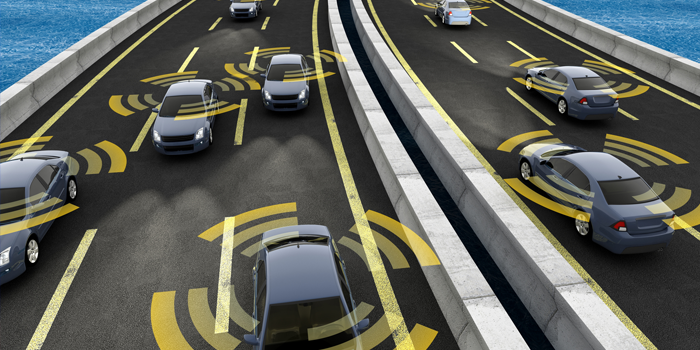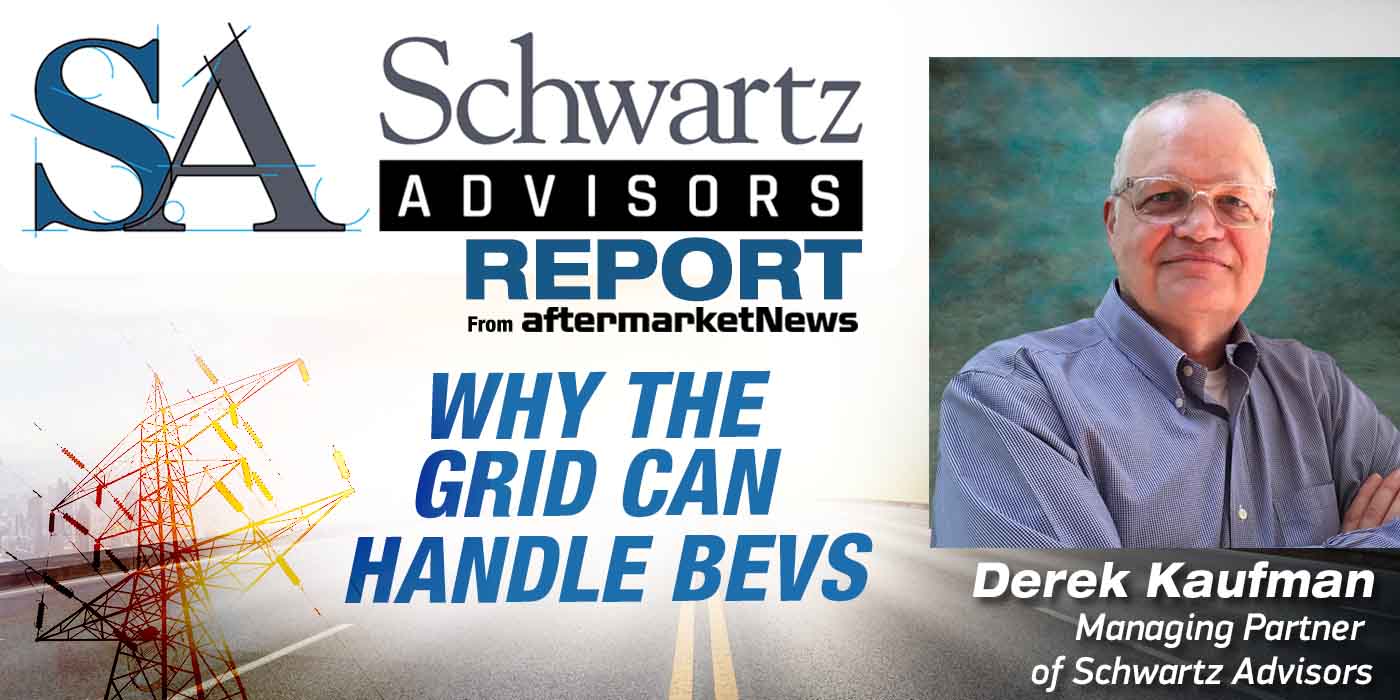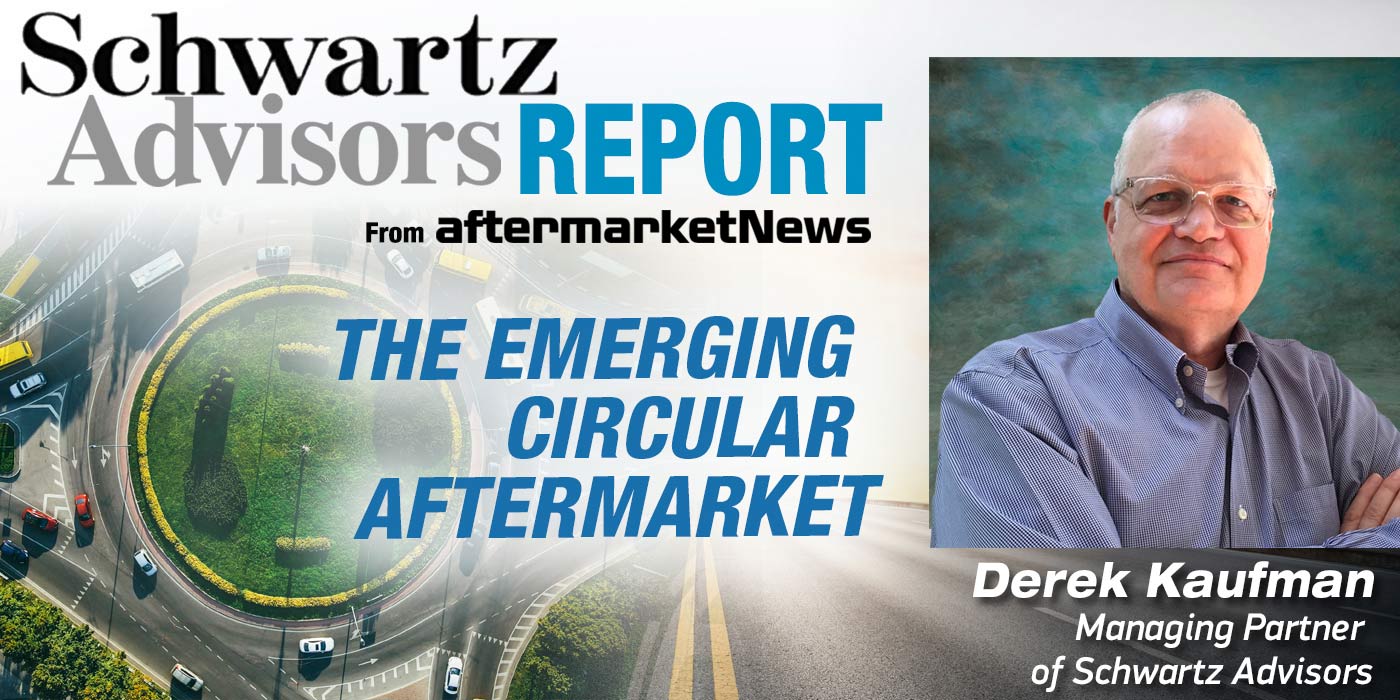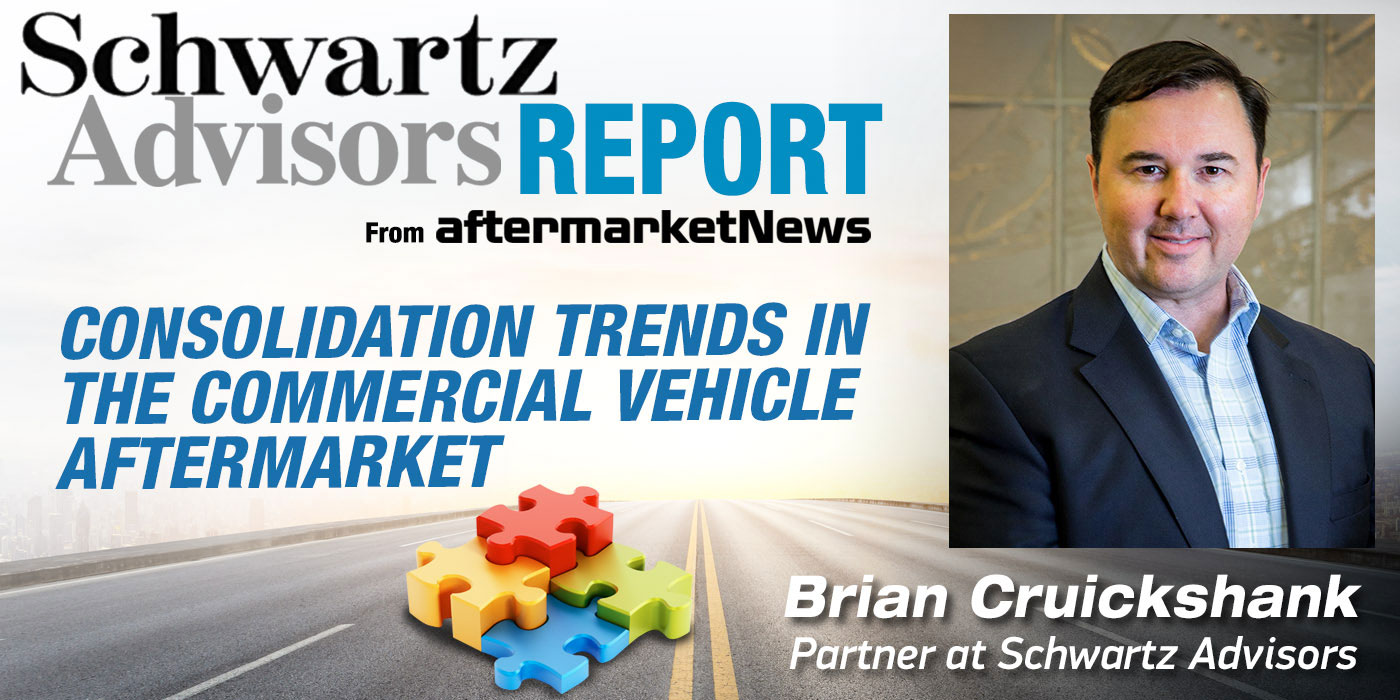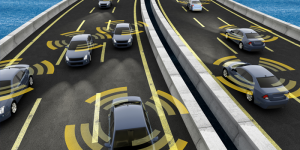
A recent report by the Bay Area think tank RethinkX, titled, “Rethinking Transportation 2020-2030,” has been picked up by numerous news organizations. It’s a report sure to concern the automotive industry and especially potential investors in the automotive aftermarket. The report is available on the RethinkX website.
We believe the report warrants some careful analysis.
The RethinkX premise is this: By 2030 – within 10 years of regulatory approval of autonomous vehicles by federal and state governments in 2020 – 95 percent of U.S. passenger miles traveled will be served by autonomous electric drive vehicles owned by fleets, not individuals, and operated in a new business model called TaaS – Transportation as a Service. Here is a synopsis of the report’s findings:
- The typical vehicle owned by individuals in the United States (referred to as IO – for Individually Owned) is only used 4 percent of the time. TaaS vehicles will have a 40 percent utilization level.
- Because of the higher utilization rate of TaaS vehicles, the number of passenger vehicles on American roads will drop from 247 million to 44 million.
- Nearly 100 million existing vehicles will be abandoned as they become economically unviable.
- Demand for new vehicles will plummet: 70 percent fewer passenger cars and trucks will be manufactured each year.
- All TaaS vehicles will be autonomous vehicles (AVs) with full electric drive. Individually owned internal combustion engine powered vehicles (IOICEs) will still represent 40 percent of the vehicles in the U.S. vehicle fleet, but they will provide just 5 percent of passenger miles.
- The report states that the average person will spend $3,400 per year on TaaS transportation rather than the $9,000/year cost of today’s typical IOICE vehicles.
- The $5,600 cost difference will widen as TaaS adoption increases, forcing the IOICE industry into a death spiral (their term not ours).
Many news organizations have run articles on the RethinkX report in the past few weeks without questioning its content. The folks from the Motley Fool investor website are quoted on the RethinkX website as saying “I am convinced that I – and you – will probably never buy another car again. Ever.”
Pause here for reflection.
Whew! It’s enough to make your author want to can some peas and head for the shelter!
But let’s step back for a few minutes to consider the RethinkX math and provide a more critical analysis of the report. We’ll start by normalizing some figures.
The RethinkX report uses “Passenger Miles Traveled,” which differs from the “Vehicle Miles Traveled” used by most aftermarket people. You can see U.S. government reports ranging from 2.9 to 4.4 trillion passenger miles traveled per year on today’s highways. The U.S. DOT figure for vehicle miles traveled (VMT) is 3.2 trillion miles per year. This is the figure currently used by the Auto Care Association so we will use it here.
RethinkX references 247 million vehicles on American roads (VIO – Vehicles In Operation). The actual figure is 270,443,000 and it grows every year. We are currently selling about 17 million new vehicles into the market each year and scrapping 4.2 percent or roughly 11 million vehicles a year.
Regarding the abandonment of 100 million of the 270 million vehicles on the road to make way for the autonomous revolution we would make the following points:
1) Remember “Cash for Clunkers”? That 2009 program eliminated 690,000 vehicles from American roads and cost American taxpayers $3 billion. It eliminated low-priced cars for low-income Americans and did not spur the sales of new vehicles as advertised. If reducing the VIO by 690,000 vehicles cost $3 billion, will 100 million vehicles cost more than $400 billion?
2) Our assumption is that a federal program paying for the removal of vehicles will not be viable, so that leaves some form of mandate to eliminate enough cars by 2030 to meet RethinkX’s 100 million prediction. The federal agency that is charged with that task will need to mandate both new car sales and used vehicle surrender so today’s 6 million net add can be reversed to a 7 million-plus reduction each year.
To quote the RethinkX report, “… there might be hostility to the driverless TaaS disruption in some jurisdictions for cultural, socio-economic or political reasons, considering that incumbent businesses will suffer losses from the introduction of TaaS. For instance, up to 5 million jobs may be lost, leading to aggregate income losses of $200 billion per year.”
We would agree. There might be some hostility to the concept.
RethinkX forecasts a 70 percent drop in new cars sales – that’s a 12 million vehicle per year reduction in output for vehicle manufacturers. The Auto Alliance estimates the auto manufacturing injects $953 billion into the U.S. economy each year and that 7.25 million people owe their jobs to the automotive industry. Forty-five states have more than 10,000 jobs related to the auto industry. Cutting that employment by the RethinkX 70 percent estimate yields the 5 million lost jobs figure.
RethinkX says IOICE cars will handle just 5 percent of vehicle miles traveled but vehicle miles traveled will increase to 6 trillion.
Let’s do more math.
If today’s 270 million vehicles in operation travel 3.2 trillion miles, that means each vehicle averages about 12,000 miles per year. Now let’s shift to RethinkX’s forecast of the 3.2 trillion miles moving to 6 trillion miles in 2030 as new business models provide all kinds of new autonomous vehicle services. RethinkX forecasts 5 percent of the 6 trillion miles will be handled by IOICE vehicles. That is 300 billion miles. Divide that by 12,000 miles per year per IOICE vehicle and you get 25 million IOICE vehicles on the roads in 2030. But RethinkX also says that 40 percent of the U.S. vehicle fleet will be IOICE cars and that 44 million total vehicles will handle the 6 trillion VMT. Forty percent of 44 million is 17.6 million IOICEs rather than 25 million. To make that work, the average speed needs to increase or the 4 percent utilization need to increase and the numbers get more confusing as you think about the operating efficiency of the AVs.
Stay with me… just a little more calculation.
RethinkX says that just 44 million vehicles will handle the 6 trillion VMT in 2030. If 25 million of them are IOICEs then the 19 million remaining vehicles (all AVs) would need to average 300,000 miles per year to cover the 5.7 trillion VMT. Not unreasonable.
But RethinkX says IOICEs operate only 4 percent of the time – that would be 350.4 hours per vehicle per year. Traveling 12,000 miles per year in 350.4 hours equals a 34 miles per hour average speed. Also not unreasonable. But here is where the math goes off the rails. RethinkX says that AVs are 10 times more efficient than IOICEs – that they will travel 40 percent of the time instead of 4 percent. So if AVs travel 3,504 hours a year and do 300,000 miles each, then each AV would average 300,000 miles/3,504 hours or 85.6 mph. Oops. We think the phrase is – “that doesn’t pencil out.”
Let’s try it again – take the 44 million vehicles times RethinkX’s 40 percent IOICE estimate – that’s 17.6 million vehicles (instead of our calculation of 25 million) leaving 26.4 million AVs to handle the 5.7 trillion miles. That’s 215,909 miles per year per vehicle. Also not unreasonable.
But if AVs are 40 percent efficient and travel 3,504 hours per year they would still need to average 61.6 mph to cover the 215,909 miles each year. Hold on to your hats you AV riders!
So what happens if AVs average the same 34 mph that today’s IOICEs average? That would mean the AVs need to be on the road 6,350 hours per year or roughly 72 percent of the time. That could be possible and maybe we misunderstood RethinkX’s 40 percent utilization efficiency reference. At least we think we did.
The authors of the RethinkX report thought through the likelihood of this type of transformation happening in a 10-year period of time. They wrote, “Behavioral issues such as love of driving, fear of new technology or habit are generally believed to pose initial barriers to consumer uptake. However, Pre-TaaS companies such as Uber, Lyft and Didi have invested billions of dollars developing technologies and services to overcome these issues.”
At Schwartz Advisors, we admit to an auto aftermarket bias – so it is not surprising for us to challenge what we see as the utopian future laid out by RethinkX. Our concern, however, is not with the predictions of a certain AV conversion in the industry. We believe that will happen and we actually think it is good for the auto aftermarket because AVs will require more frequent and more consistent service simply based on the miles they drive.
Our concern is with the 24 hours news cycle that picks up a report like this and simply parrots the headlines that 95 percent of all miles traveled in 2030 will be by electric drive AVs that have essentially displaced more than 200 million vehicles on American roads. The math would suggest that is not possible.
Love of driving, fear of technology and habit are certainly, as RethinkX notes, “initial barriers” to adoption, but we would pose another one that is larger than all of these combined – convenience. When we want to go, we want to go. To many of us, that convenience is well worth the holding cost of a vehicle sitting in the garage. Yes, AVs can show up in minutes in an urban center, but will you suburbanites wait for 15 minutes to head to a restaurant that is 15 minutes away? If you argue that more AVs could be added to the country to lower the wait times for non-urban users, then the 44 million vehicles of RethinkX’s prediction falls apart.
We have not done the exhaustive research referenced in the RethinkX report, but we have been in the transportation industry a long time, so we will offer another scenario of AV adoption based on our experience and some scenario modeling we like to call “fun with numbers”:
- Vehicle-Miles-Traveled will move from 3.2 to 4.5 trillion as AVs unlock transportation alternatives for the very young, the very old and lower income people who cannot afford to own vehicles.
- Baby boomers will live longer and begin to adopt more AV use as they get older.
- AV adoption in urban centers will be incentivized through a combination of AV taxi and car share programs, AV congestion reduction incentives, dedicated AV lanes etc.
- Twenty-five percent of all miles traveled in 2030 will be AVs but they will be a combination of full electric drive and ICE/electric hybrids.
- 281,250,000 IOICEs (about 50 percent of which are hybrid vehicles) will continue their 12,000-mile per year usage rate happily sitting in our garages ready at our beck and call.
- 4.5 million AVs (BEV, PHED, ICE-Hybrid) will each travel 250,000 miles a year at an average speed of about 40 mph.
- The vehicle scrap percentage will climb slightly from 4.2 percent to 6 percent over the period as AVs displace existing IO vehicles.
- The combination of AV TaaS businesses, car sharing, and fractional use business models will reduce new car sales by 300,000 to 500,000 vehicles per year.
- IO Pickup trucks will continue to lead USA sales.
We welcome your comments.
About Schwartz Advisors and This Article
Derek Kaufman is a managing partner at Schwartz Advisors (SA). SA is a team of highly experienced auto aftermarket experts working with clients in corporate growth projects and both buy-side and sell-side merger and acquisition activities. As part of its growth consulting work, SA keeps current with the emerging technologies and business models that will drive the future supply of automotive parts and service. The reference to any specific commercial products, processes, or services by trade name, trademark, manufacturer or otherwise, does not necessarily constitute or imply its endorsement, recommendation, or favoring by Babcox Media or Schwartz Advisors. The views and opinions of the author do not necessarily state or reflect those of the Babcox Media staff.

